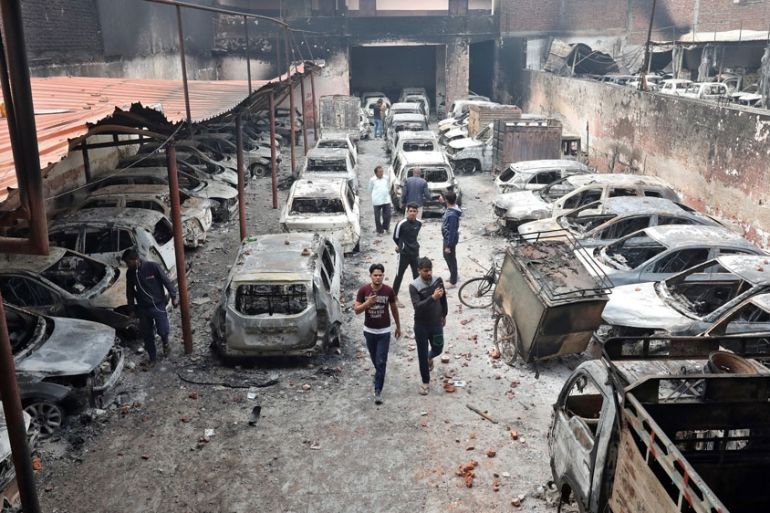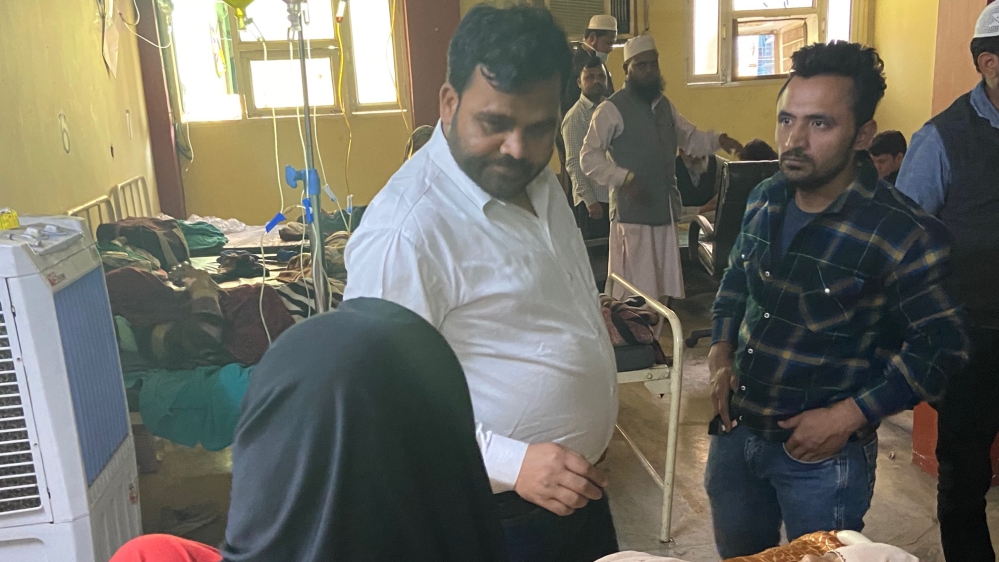‘What do we do now?’: Delhi carnage survivors recount horror
People point finger of blame at police and governing party leader for worst violence in decades that has left 42 dead.

New Delhi, India – On the night of February 24, Al-Hind Hospital, located in the narrow and crowded lanes of Mustafabad in the northeast of the Indian capital, was overwhelmed by patients.
“At first, we thought that few people must have been injured in clashes but soon after we realised that it was like some disaster had struck the area,” said Dr MA Anwar, the hospital director.
Keep reading
list of 3 itemsIn Pictures: Anti-CAA sit-ins attacked in Indian capital
New Delhi hit by worst violence in decades: What you need to know
“We were losing count of the injured who were trickling in one after another,” he told Al Jazeera while taking a round of injured patients at the 15-bed hospital.
The hospital has treated more than 600 people injured in the violence triggered after Hindu nationalists attacked protest sit-ins against a discriminatory new citizenship law.
Muslims are demanding a rollback of the law that they say is against India’s secular constitution. They fear they will be relegated to second-class citizens by Prime Minister Narendra Modi’s Hindu supremacist agenda.

The death toll has risen to 42 people in the worst religious violence to have hit Delhi since 1984, when more than 3,000 members of the Sikh community were killed by a Hindu mob following the assassination of then-Prime Minister Indira Gandhi.
Dr Anwar says he has not slept more than five hours a day since Monday. He accused the police of inaction and blamed hate speech by ruling Bharatiya Janata Party (BJP) leader Kapil Mishra for the violence.
Mishra on Sunday warned Muslim protesters to wind down sit-ins in Jafarabad and Chandbagh areas or face the ire of his supporters. The next day, a Hindu far-right group went on a rampage, resulting in pitched street battles between the communities in parts of northeast Delhi.
Mosques, shops and houses were set on fire, forcing many people from mixed neighbourhoods to move to safer areas. Many journalists were attacked while reporting on the events.
“He [Mishra] said all of this in the presence of the police. If the police had taken action against Mishra on that day itself, so many people would not have died,” said Dr Anwar.
The doctor, assisted by his three brothers, worked through the night to ensure the injured were given necessary medical aid. He says the situation worsened the following night, Tuesday, as the number of injured increased.
“On February 25 … it was like nothing that I had witnessed before. Even our doctors and nursing staff started crying after looking at the injuries of the victims,” he said, adding that most people were brought in with bullet, pellet or stab wounds.
Dr Anwar says many of the seriously injured needed to be moved to bigger hospitals but the mob had blocked the ambulances’ path.

The hospital, situated a few meters away from the epicentre of the violence in Bhajanpura area, sent out distress calls as the injured poured in.
Ambulances were finally allowed through at the directive of the Delhi High Court following a petition filed by activists.
“Even in war zones, the army creates a safe zone for the passage of ambulances but here they weren’t even allowing those,” Dr Anwar told Al Jazeera.
Most people Al Jazeera spoke to in the violence-affected areas, including Hindus, blamed Mishra, the BJP leader, for disturbing the peace in the region.
“They had been holding peaceful protest at Jafrabad since December and not one person was harmed or vehicle torched, and a day after Mishra made these statements, Delhi has turned into a war zone,” said Daulat Kumar, an autorickshaw driver from Gokulpuri.
Meanwhile, violence-affected areas such as Karawal Nagar, Khajuri Khas, Seelampur, Maujpur, Bhajanpura, Vijay Park, Jafrabad, Chandbagh, Mustafabad, Gokulpuri and Yamuna Vihar remain tense, with people keeping to their homes amid a heavy police presence on the streets.

The smell of burned tyres, vehicles and properties lingers in the air and people come out to talk to journalists. In one such neighbourhood in Chandbagh, more than 50 Muslim women surrounded this reporter, sharing their stories and pleas for help.
With tears rolling down her cheeks, Shahana Begum narrated how the mob set fire to their two shops in Bhajanpura, a Hindu-majority area opposite Mustafabad.
“We were told that our shops had been set on fire. What do we do now? We had invested everything in those shops and now we don’t know how we will feed our children,” Begum told Al Jazeera.
Shagufta, standing near Begum, narrated how she and three other Muslim families had to flee from Gokulpuri after the mob reached their neighbourhood.
“Our Hindu neighbours saved us otherwise they would have killed us. We have come to our parents’ house because it is safer here,” she said. Several other women told similar stories with many of them crying out of fear.
“We do not sleep at night. My young siblings are so scared that they hardly speak. What have we done to deserve this? We are also Indians and were only protesting against the CAA [Citizenship Amendment Act]. We did not indulge in any violence and yet they killed so many of us,” said 19-year-old Zainab Khan.
As the women told their stories, some men who had gathered said that if this is how they [government] want to treat Muslims, they should give us our own country.

Hearing this, Zainab shouted back: “This is our country and we will live and die here. We too have sacrificed for this country and want to live in peace with the Hindus. Nothing of this sort happened here ever, why is it that after BJP came to power we are witnessing these communal tensions? It is the BJP and the police that is responsible for this mayhem.”
A few metres away, a Hindu woman, who did not want to be identified, was looking for her bike, which she had left behind after the violence erupted on Monday. After 20 minutes of going through piles of burned bikes, she found it.
“What wrong did I do? I just teach young children of all faiths. Why did this happen?” she asked, blaming Mishra for riling people up.
“None of this would have happened if he didn’t make that speech. They had blocked the road but were peaceful for more than 70 days. They could have challenged it in court and followed legal procedure,” she told Al Jazeera.
There was a lot of anger among the locals against the police, which they said assisted the mob in targeting Muslims and their properties. “[Home Minister] Amit Shah’s police took sides,” said Ahmed Khan of Khajuri Khas.
“I was in Delhi when the 1984 riots happened. It was similar to what happened back then. If the police wanted, they could have stopped clashes on the first day but they had clear instructions from the top to let the rioting continue,” Khan said.
At the Guru Teg Bahadur Hospital mortuary, Mustakhim Ali is among dozens of people waiting for the body of a family member killed in the violence. He wants to perform his cousin Mohsin Ali’s last rites but the body has not been released yet.
Mohsin Ali, 22, was from Hapur in northern Uttar Pradesh. He ran a small business providing generators for marriage parties and had come to Delhi for business on Tuesday.
Mustakhim Ali said when they found the body of his cousin, who got married himself last December, they did not recognise him.
“He had no clothes on his body and his head and face was swollen and covered in blood. It was only after his father identified him, we were sure that our brother had died,” said Mustakhim Ali.
“What sort of society are we living in where people are being killed because of their religion under the watch of the police. My brother worked hard day and night to establish his business. Little did he know that he would meet his end so brutally. God will never forgive those who killed him.”
